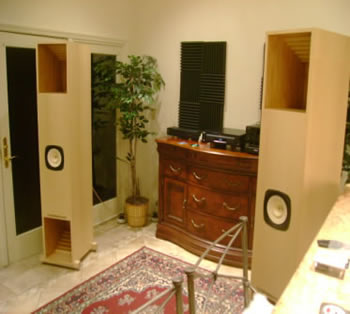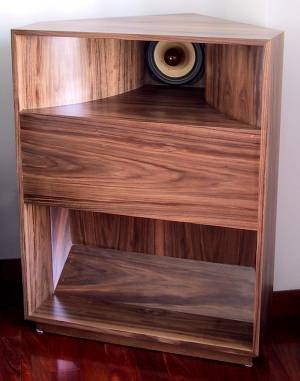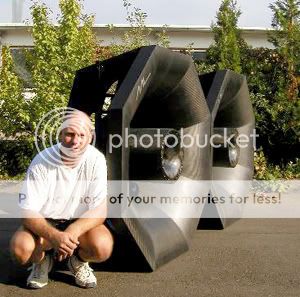i discovered today a homepage, which shows a Compound hornloudspeaker , invented 1936 by Harry F. Olson und Frank Massa.
It seems to me this speaker configuration has been completely forgotten , but looks amazingly clever. These guys were far ahead of their time.

it would not be easy to be built, but the result might be worth the effort.
more about it at my forum
Angelo
It seems to me this speaker configuration has been completely forgotten , but looks amazingly clever. These guys were far ahead of their time.

it would not be easy to be built, but the result might be worth the effort.
more about it at my forum
Angelo
Hornloaded on front, tl on back. Is that right? The driver would experience loading on both sides is my guess, better?
There's a few more designs like that, way back everybody wanted to get as much from one woofer as possible.
On a tangent
Have you heard a Tasco Harwell 215 bass unit?
There's a few more designs like that, way back everybody wanted to get as much from one woofer as possible.
On a tangent
Have you heard a Tasco Harwell 215 bass unit?
I don't think so. I imagine GM would know exactly which of Olson's designs it is, but FWIW, the picture's dodgy, but it looks to me like an early version of one of his Studio horns. There might be some QW / TL action in the bottom octave of the bass-horn's BW, but it's going to be maintaining horn loading down a long way compared to a lot. You're only seeing 1/2 of the total horn CSA there as it's using concentric radiation (mouth on the top, bottom & both sides) & unless I've missed my guess, it'll be running anything from an 8in to a 15in driver, which gives you some idea of the size of the thing.
Anyway, compound horn = one of the better compromises when a back-horn gets involved, & 7 decades on Olson's horns are still amongst the best around. Fairly rare, mainly due to their size & complexity, as well as the difficultly of matching the outputs from the front & rear. They're not unknown though -Tannoy have been using compound loading with their GRF Autographs & now Westminster Royal's since the 1960s (not that I rate them very highly).
Anyway, compound horn = one of the better compromises when a back-horn gets involved, & 7 decades on Olson's horns are still amongst the best around. Fairly rare, mainly due to their size & complexity, as well as the difficultly of matching the outputs from the front & rear. They're not unknown though -Tannoy have been using compound loading with their GRF Autographs & now Westminster Royal's since the 1960s (not that I rate them very highly).
the throat of the basshorn surrounding the HF horn is a big advantage, the transducer acts almost like a true pointsource - and hornloaded gives that " fast " and powerful bass. the backwave not in phase: i don't see any problem, since the frequency band is another one than of the MH - almost no cancellation will occure. what i do not like - is the format. In fact it would be very large - not useful for most homes. However, the cabinet could be shaped .
Stephan Stoske made a similar designstudy with his Wellenwannenhorn:

Stephan Stoske made a similar designstudy with his Wellenwannenhorn:

I have been searching for info on compound horn systems for a while, mostly without much result. At least none beyond the Tannoy autograph.
Recently I found the Lowther TP1 London ( or Isis, depending on where the info comes from).
I also found another Olson patent #2224919, for a compound horn loudspeaker. I used Google patent search. The rear horn looks very similar to the work ascribed above, the influence he had on Nagoka is evident too.
I'm interested in the Lowther design because it utilizes an 8" fullrange driver, while I'm not of means to afford the Lowther driver, the specs. seem to favor replacement with a Fostex FE206, or the like, which I could actually afford in this lifetime. I would like to better understand the design and implementation of horns though, as I've little interest in a corner enclosure, I could measure the CSA of the Back horn on the TP1, and length, expansion etc, and try to design a new folding resulting in something not requiring corner loading ( which I've read the TP1 didn't require anyway).
I'm just not educated enough to make the judgement as to whether I would be wasting my time and effort to construct such a cabinet. Taking into account the rising nature of the response of the FE206, you would need horn loading to eq the bass, while having enough rear chamber to high pass the mid's to the front horn which would need to horn load the mid's with a roll off to the rising top end. I would like to not have to use a contouring filter, or have to pad down the response, as I'd like to drive these with a low watt class A amp with a pretty low damping factor.
Any comments or suggestions?
John
Recently I found the Lowther TP1 London ( or Isis, depending on where the info comes from).
I also found another Olson patent #2224919, for a compound horn loudspeaker. I used Google patent search. The rear horn looks very similar to the work ascribed above, the influence he had on Nagoka is evident too.
I'm interested in the Lowther design because it utilizes an 8" fullrange driver, while I'm not of means to afford the Lowther driver, the specs. seem to favor replacement with a Fostex FE206, or the like, which I could actually afford in this lifetime. I would like to better understand the design and implementation of horns though, as I've little interest in a corner enclosure, I could measure the CSA of the Back horn on the TP1, and length, expansion etc, and try to design a new folding resulting in something not requiring corner loading ( which I've read the TP1 didn't require anyway).
I'm just not educated enough to make the judgement as to whether I would be wasting my time and effort to construct such a cabinet. Taking into account the rising nature of the response of the FE206, you would need horn loading to eq the bass, while having enough rear chamber to high pass the mid's to the front horn which would need to horn load the mid's with a roll off to the rising top end. I would like to not have to use a contouring filter, or have to pad down the response, as I'd like to drive these with a low watt class A amp with a pretty low damping factor.
Any comments or suggestions?
John
angeloitacare said:i discovered today a homepage, which shows a Compound hornloudspeaker , invented 1936 by Harry F. Olson und Frank Massa.
It seems to me this speaker configuration has been completely forgotten , but looks amazingly clever. These guys were far ahead of their time.

it would not be easy to be built, but the result might be worth the effort.
more about it at my forum
Angelo
I see a double mouth back loaded horn for low frequencies.

And a front loaded mid high horn
so it is like this one

So I ask my self Angelo what is here re discovered?
It's true, nobody has build any of Olson's Studio Horns for years, more's the pity (wish someone would re-introduce his 15in FR driver too). That said, the influence is still alive & well. The CarderSound Madison double-horn in the photograph was designed by muggins here & its internal configuration was inspired by Olson's horns, as are my long-path Spawn designs on the frugal-horn site.
It is a horn with front and back loading.angeloitacare said:hello Helmut
i don't know what is your point . Nobody , as far as i know, build the Olson horn anymore, and it was not mentioned for a long time. Only Stefan Stoske , member of a german forum, gave a link to a homepage showing it.
Angelo
How do you mean compound? You don't understand the principle I think.
It is not a system that is forgotten I remember seeing lowhterhorn build front and back loaded.
here I found one.

I see a double mouth back loaded horn for low frequencies.
the Olson horn is backloaded on all four sides, the mouth of the backloaded horn surrounds the frontloaded horn mouth, making it a point source, with e even dispersion characteristics. This is in my opinion the most remarkable advantage, and is what distinguishes it from other compound horns, front and backloaded. Space was not a concern for Olson horn applications, since it was used in Radio Studios etc. ; today, unfortunately, for a average listening room, it is. A similar solution was adopted by
Karl-Heinz Theis
http://www.mlaudio.de/index.php/site/C11
( no pictures at his homepage available of these horns )

mightym said:
........ the specs. seem to favor replacement with a Fostex FE206.......
I would like to better understand the design and implementation of horns though, as I've little interest in a corner enclosure.......
I'm just not educated enough to make the judgement as to whether I would be wasting my time and effort to construct such a cabinet.
Yes, though only if you drive it with an appropriate amp, otherwise you'll have to design from scratch around the desired amp's specs for best performance.
Well, not having the math skills to design as Olson, et al did, I armed myself with a kit built sine-square generator, o'scope and spent ~seven months of my young life experimenting with all manner of BR, TL, horn design 'proof-of-concepts' to try to get enough of an understanding to design my own and by far the compound horn was the hardest to get 'good enough', but was the most enlightening overall, so if learning is the primary goal, then I say go for it, otherwise with today's plethora of driver choices, quality digital XO's/EQs/TDs and design/measurement software, a WG loaded HE wide BW driver coupled to one or more large HE woofers XO'd < ~300 Hz is the best compromise overall IMO.
GM
Scottmoose said:(wish someone would re-introduce his 15in FR driver too).
That would be sweet.
dave
- Status
- This old topic is closed. If you want to reopen this topic, contact a moderator using the "Report Post" button.
- Home
- Loudspeakers
- Multi-Way
- Compound hornloudspeakers